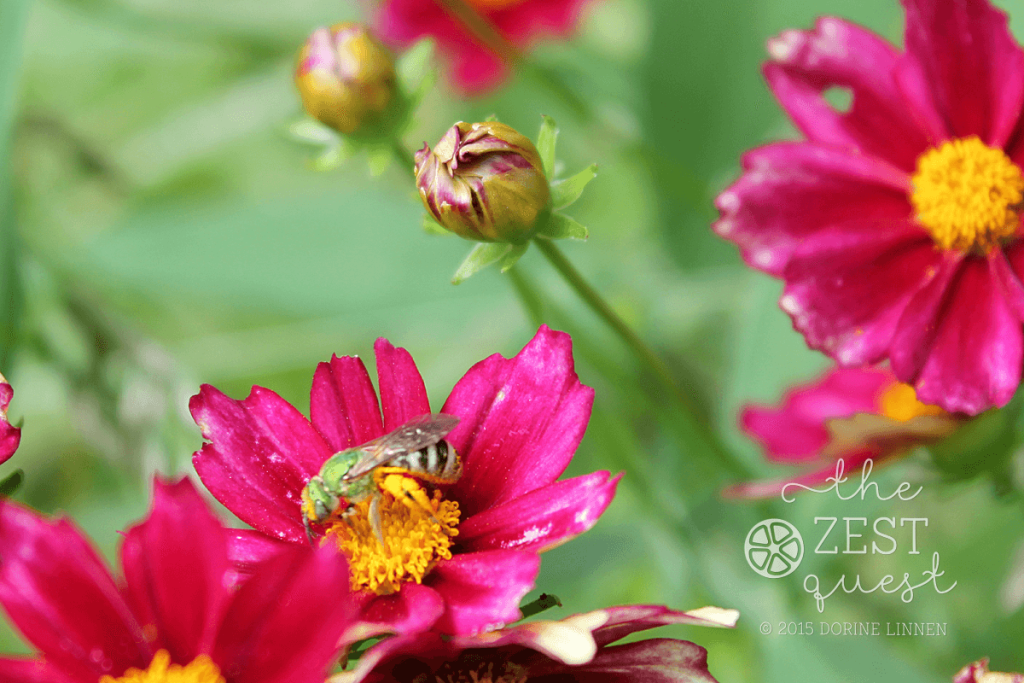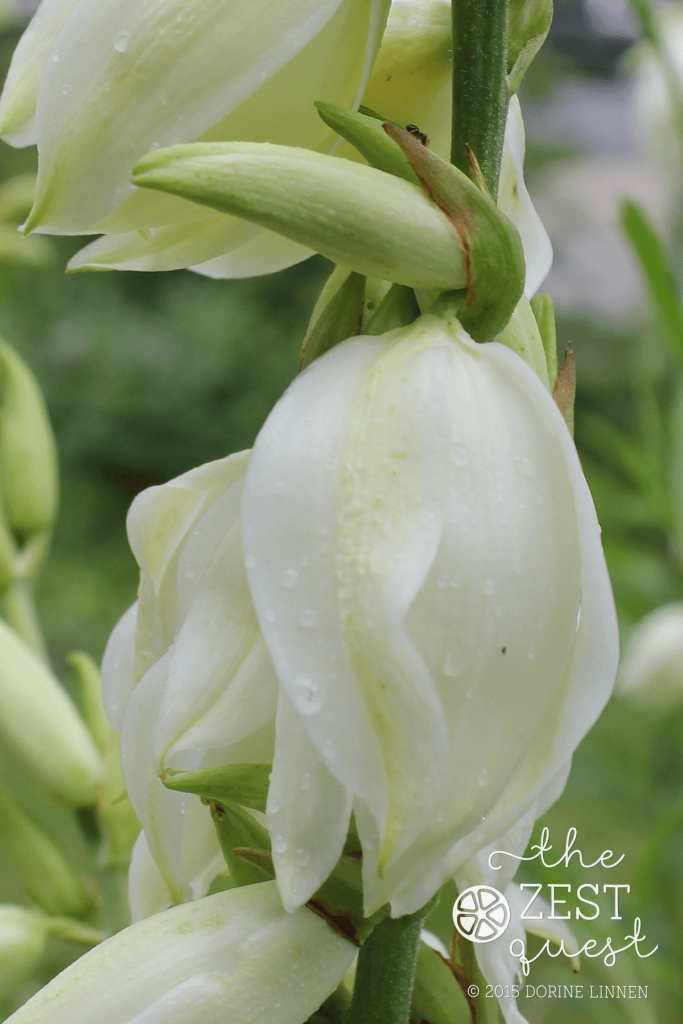It has rained more in June than it has done anything else this year which has made photography more adventurous. I’m learning the beauty of raindrops on flowers magnified, such as these white blooms from the Yuccas below, because they’re usually there when I sneak in to take pictures in-between torrents. Even through the rain, there is much more in bloom in the latter half of June than there was in the first half when I posted part one. The precipitation has also increased the insect population, and the weeds, so they’re getting photographed too. The great news is that I haven’t had to water the babies that are in pots waiting for a dry spell for me to plant them and they’re still happy to be in those well-drained pots instead of the soggy ground.
My garden is mostly shade so it’s easier to take care of in a wet season because my perennials fight the tree roots everywhere. Only the tough and tenacious survive here because I am not the type of gardener who waters much at all – it’s the survival of the fittest, or you get replaced with some other plant I can’t resist! HA!
I don’t think I’ve ever waited until almost the end of June to plant my vegetable garden in the past, so this will be the year of experiments. I couldn’t help but smile when most of the tomatoes, peppers, squash and cucumbers were finally planted. I still have a few more veggies to plant but I’m just enjoying each moment I get to dig as they come. There’s just such a sense of well-being that occurs when you see those lovely plants in their places and the possibility of picking the fruit you’ve dreamed about starting to take shape. It’s soothing and hopeful and a blessing since the plants are so forgiving of what I’ve put them through while they’ve waited for their destination. Once I’m finished planting, I’ll share the results.
Everything is extra lush in the garden, including the weeds, but all this wet also makes them easy to pull up in big chunks, roots included, so the only problem is being able to move fast enough in-between raindrops to get it all done. The above photo is a larger view of the Yuccas in full bloom with the blue green foliage of Baptisia alba (white False Indigo) in the background. Rose of Sharon is popping up everywhere in-between – weeding is never completely done in a cottage garden.
I took a photography class a few weeks ago with the Summit County Master Gardeners at their Meet Me in the Garden program at the Nature Realm, which focused on insects in the garden, so these pictures are the results of playing with some of those techniques. I’ve always taken pictures of bees and butterflies, but now it seems more fun zooming in to see what I can’t see with the naked eye. The pollen on the bee’s legs above in the top feature photo of Coreopsis Mercury Rising is fascinating and something I didn’t think about before this. Expect more insect mania to come because I think I’m addicted, and obviously need more practice so I can show you the powder puff of pollen on bees in better focus. The best part? Knowing that the journey of discovery is ahead and I am ever hopeful of what I will find.
Such as, who knew that flies would be vying for the pollen right along with the bees as in this photo below of Heliopsis helianthoides (perennial False Sunflower), which I believe is the variety ‘Summer Sun’ if I remember correctly. The above photo is the same flower right before it opens. If this fly below (maybe a sweat bee?) isn’t interested in the pollen, I really don’t want to know what he’s doing there so keep me in the dark, thank you very much.
I adore Coreopsis (Tickseed) so they’re allowed to spread significantly in my cottage garden. I’ve had Coreopsis verticillata ‘Moonbeam’ and ‘Zagreb’ for years, but I’m not sure if they’ve both survived or it’s just one of them that’s prominent in the garden right now. Last year I added Coreopsis rosea ‘Mercury Rising’ which is above in the featured photo with Mr. pollen-laden Bee, and another I just adore pictured below, Coreopsis verticillata ‘Route 66’. The blue green leaves in the background belong to the wild pink sweet peas that pop up wherever they want and weave themselves into my other plants. The photos I took of them were too blurry so I’ll have to try again so you can appreciate why I don’t yank these as weeds. Number one reason is that the hummingbirds love them, especially since they’re wound amongst everything in my “red” garden.
More from the red garden is Monarda didyma ‘Jacob Cline’ (Bee Balm) before and after it blooms. This ‘before’ bloom features a little caterpillar that didn’t look beneficial so the “friend who will remain unnamed’ squished him after the photographs the next day. Eep! Gone baby gone!
Bee Balm is such a favorite of mine which is why it’s allowed to stay in the garden when it rages with leaf mold and looks horrid more than half the season. I even added a pink blooming variety as well, but they haven’t bloomed yet and sadly, I can’t remember where they are! So, when they bloom, I’ll show them off and let you know if they’re more resistant to the dreaded mold. When ‘Jacob Cline’ is in full bloom, the hummingbirds visit daily. My solution to the mold? Cut them back and hope for drier weather when they might bloom a second time.
One of my new favorite plants in the garden is Penstemon ‘Dark Towers’ pictured below. That burgundy foliage with pink and white blooms is gorgeous most of the season. It does have a tendency to attract aphids and the four line bug, so it’s not without problems. I use an organic insecticidal soap if it gets too bad, but mostly I let nature take care of nature and appreciate what it gives each day.
Blooms aren’t the only things appreciated in this mostly shade garden so I’ll share some of the awesome foliage next month. A shade garden isn’t always prolific with flowers so the foliage has to be fully appreciated and used for more color. Also appreciated are the fruit in seed pods or berries such as these gorgeous fruits from Cornus sericea, Red Twig Dogwood below. I love how the berries go from a lime green to soft egg-shell blue amongst the red twigs. I have both the Yellow Twig and Red Twig Dogwoods in the shadiest part of the back garden so they get really tall and floppy, but there’s nothing like those red and bright yellow green twigs against a winter’s snowfall either.
Finally, Dictamnus albus, my favored Gas Plant, talked about in a previous post is showstopping once again with its unusual seed pods as they ripen. Who can resist that?
What’s blooming in your world?

